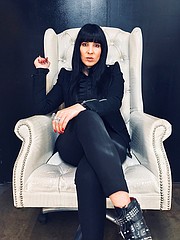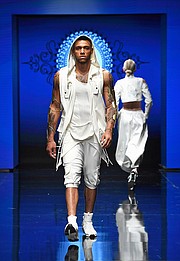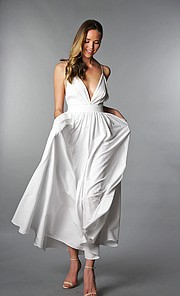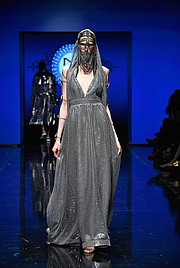FASHION
From Colombia, With Love, Nathalia Gaviria Rediscovers Herself in Los Angeles
Never forgetting her Colombian roots, Nathalia Gaviria now calls Los Angeles home, where she has a flagship store called Nathalia Gaviria: Black on Melrose Avenue. Facing many challenges along the way to fashion-design success, Gaviria has allowed hardship to fuel her desire to achieve greatness and guide the members of the next generation of Los Angeles designers toward fulfilling their goals. Gaviria talked with the California Apparel News about reclaiming her original style of festive clothing and her journey to becoming a fashion designer.
When did you decide you wanted to be a fashion designer and why?
As a kid, I always liked clothing and found it very interesting—colors, textures and how you can mix them together to create unique pieces.
How did you make that happen?
When I graduated from LCI, a design school in Colombia, in 2000, there was a fashion competition for designers from all over the country. Whoever won would win a scholarship to go to Miami to study fashion merchandising at the Miami International University of Art & Design. My inspiration for the contest design was a protest about Colombian people who were taken off of their land by a big petroleum company. The collection was very controversial because it featured a man wearing a woman’s dress. I also invited two indigenous ladies to walk the runway. The people in the audience were so excited to see that dress. That is how I won.
Who was the person who helped you the most in becoming a fashion designer?
My mother, Helena, was always supportive. Always by my side, always supportive, always helping.
Looking back on your first collection, what was it like and how would you change it now?
My first collection was inspired by the circus. It was very colorful and fun. After those early collections, I stopped doing colorful, fun clothes for many years but decided to come back to it. Looking back, I wouldn’t change it. I loved it. It might be busy, but it’s part of who I am.
What are the biggest challenges you find in creating a collection and how do you overcome them?
When I am creating a collection, I can’t choose a favorite. Sometimes it is also challenging to make it edgy without losing wearability. Creating basic pieces is difficult for me.
Where do you get your inspiration?
My last collection was inspired by the Bedouin tribe in the Middle East. It was very interesting because they cover their faces, their heads and it’s very mysterious. My inspiration can come from anywhere. My future NG Gold collection is going to be about toys from my childhood. The second is a post-punk, ’80s time period. It’s inspired by a song from the band Sisters of Mercy.
What is your favorite part of being a fashion designer?
Everything. Choosing the team, thinking about the theme, who is wearing it and the music. From the moment I have to create a collection, I know what music will be played during the fashion show.
What skills are necessary to be a good fashion designer?
You need to be creative, but you should know how to sew and make a pattern—you need to know how to do your craft.
How would you describe your personal style?
I hate when people put me in a box. Sometimes I look bohemian, another day I am dark and the next I am sporty. You can have 10 styles but it’s the same you.
What is the best and worst feedback or critique you have received and from whom?
In December, I was invited to Dubai to show the collection inspired by the Bedouin. They thought it was interesting that an outsider to the culture was inspired by them. To see that they got it was the biggest compliment. A friend once asked, “I always wonder, do you laugh when you design your clothing?” She was saying my designs are ridiculous and I must laugh at the thought of someone buying them.
How has the Los Angeles fashion industry changed since you started?
I love Los Angeles to death, but L.A. is growing into a place where artists are not welcome. The rents are too expensive and big corporations are taking over. If I see a cool, young fashion designer who has a great dress, I will sell it in the store. It is so difficult to grow. I know it because I lived it.
What advice would you give to emerging designers?
Believe in their style and ideas. It’s hard for a person who has a different vision to be successful in the United States. Society is changing, so when you stick to your guns and do the work, you will see success.

























